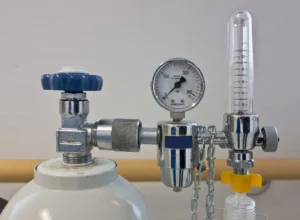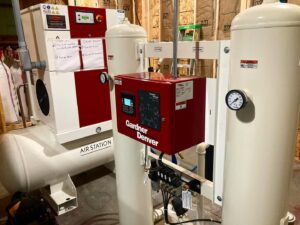Business
Safety Tips for Compressed Air Dryers
Published
4 months agoon
By
Admin
Compressed air dryers are crucial components in many industries, says Super-Dry Systems, helping to remove moisture and other contaminants from compressed air systems. While these systems are highly beneficial, they can also pose significant safety risks if not handled correctly. Whether you’re operating a compressed air dryer in a manufacturing setting or maintaining it for another industrial application, understanding safety best practices is essential to prevent accidents, system malfunctions, and costly downtime.
What Is a Compressed Air Dryer?
A compressed air dryer is a device used to eliminate moisture from compressed air, which can otherwise cause damage to tools, machinery, and the air system itself. There are several types of compressed air dryers, each designed for specific applications:
- Desiccant Dryers: Use a desiccant material to absorb moisture from the air.
- Membrane Dryers: Use a special membrane to filter out water vapor.
- Refrigerated Dryers: Cool the air to condense and remove moisture.
Each type has unique safety considerations depending on its design and operation.
Why Safety Is Critical with Compressed Air Dryers
Improper use of compressed air dryers can lead to a range of hazards, from minor accidents to severe system damage. Risks include over-pressurization, which can cause parts of the system to explode, and electrical hazards from improper grounding or faulty components. Moisture buildup can also lead to corrosion, negatively impacting air quality and increasing the risk of failure in downstream equipment.
Understanding the Components of Compressed Air Dryers

A compressed air dryer is made up of several key components, each with its own safety requirements:
- Filters: Trap contaminants and need regular cleaning or replacement to prevent blockages.
- Valves: Control airflow and pressure levels. Malfunctioning valves can lead to over-pressurization.
- Drying Media (Desiccant, Cold Coils, and Membranes): These components remove moisture and need regular maintenance to ensure they function correctly.
Installation Safety Tips
Installing a compressed air dryer properly is crucial for long-term safety and efficiency. When setting up:
- Choose the Right Location: Install in a well-ventilated, dry area to prevent overheating and moisture buildup.
- Maintain Proper Spacing: Ensure enough space around the unit for maintenance and proper airflow.
- Check Electrical Connections: Proper grounding is essential to avoid electrical hazards.
Operation Safety Tips
During operation, it’s important to keep the system within safe pressure ranges. Always monitor pressure gauges and avoid letting the system exceed its recommended operating pressure. Additionally:
- Handle Compressed Air with Care: Direct contact with compressed air can cause injury.
- Avoid Wet or Hot Surfaces: Moist air can cause condensation in the system, and certain parts may become hot during operation.
Maintenance Safety Tips
Regular maintenance is key to avoiding system failure and ensuring safety. Make sure to:
- Inspect Filters and Drying media. Clean or replace these components regularly to ensure proper airflow.
- Check for Leaks: Even small air leaks can lead to over-pressurization or inefficiency.
- Test Safety Valves: Ensure valves are functioning properly to avoid pressure buildup.
Pressure Safety Guidelines
Compressed air dryers operate within specific pressure ranges. Exceeding these limits can lead to dangerous conditions, including explosions or mechanical failure. Always:
- Monitor Gauges: Keep an eye on pressure levels to ensure they are within safe ranges.
- Set Safety Controls: Use pressure relief valves and automatic shutdown features to prevent over-pressurization.
Electrical Safety Measures
Compressed air dryers often require electrical power, which presents its own set of hazards. Be sure to:
- Check for Proper Grounding: Ensure the system is grounded to prevent electrical shocks.
- Inspect Wiring: Regularly inspect the system for frayed wires or loose connections.
Avoiding Contaminants in the Air Supply

Contaminants like oil, dust, and moisture can significantly reduce the efficiency of your compressed air system and lead to dangerous malfunctions. Install proper filters and regularly clean them to ensure the air quality remains high.
Emergency Shutdown Procedures
In case of a malfunction, it’s crucial to know how to shut down the system quickly and safely. Always:
- Identify Shutdown Switches: Familiarize yourself with the system’s emergency shutdown features.
- Act Fast: If you notice any unusual noises, vibrations, or pressure spikes, shut the system down immediately.
Safety Gear and Personal Protection
When working with compressed air dryers, personal safety gear is a must. Depending on the specific operation, you should wear:
- Gloves: To protect your hands from hot surfaces.
- Goggles: To prevent eye injury from flying debris or compressed air.
- Ear Protection: Since compressed air systems can be loud.
Training and Certification Requirements
Operating a compressed air dryer requires proper training. Many companies require operators to undergo certification programs to ensure they understand how to use the equipment safely and effectively.
Recognizing Signs of System Failure
Pay attention to warning signs like:
- Unusual Noises: Could indicate mechanical failure.
- Pressure spikes: may be a sign of overpressurization or valve malfunction.
- Reduced Air Quality: Can point to clogged filters or contamination in the system.
Conclusion
Safety should always be the top priority when working with compressed air dryers. By following these tips and keeping up with regular maintenance, you can ensure that your system operates efficiently and safely. Whether you’re an operator or a maintenance technician, staying vigilant about safety can prevent accidents and keep the system running smoothly.
FAQs
- What is the most common risk associated with compressed air dryers?
The most common risk is overpressurization, which can lead to system failure or even explosions. - How often should I inspect my compressed air dryer?
It’s recommended to inspect the system every month and perform a detailed maintenance check every six months. - Can compressed air dryers be used without filtration?
No, filtration is essential to remove contaminants that can damage the system and affect air quality. - What is the best way to prevent overpressurization?
Install pressure relief valves and set them to the appropriate safety levels for your system. - Do I need special training to operate a compressed air dryer?
Yes, proper training and certification are often required to ensure safe operation of the equipment.
You may like

Efficient ACA Compliance Management with ACA-Track

Key Software Systems: Future-Proofing Courier Operations with Technology

Refrigerated Trailers: Benefits and Uses

100 Dynamic Duos: Legendary Pairings That Transcend Time
ARK: Survival Evolved Game Icons and Banners

cute:i1cdycptg50= drawings

Understanding New York Sports Club Membership: What It Offers and What Affects the Cost

Safety Tips for Compressed Air Dryers

drawing:23vyczbybxu= billie eilish

drawing:056aoyw74ce= rick and morty

How can online food delivery sales increase and attract the maximum number of customers in 2023?

MEP BIM: Revolutionizing Building Infrastructure Design

Revolutionizing Industries with ChatGPT

Resolving the Israeli-Palestinian Conflict: A Comprehensive Analysis

Skillful Passion: Wisconsin’s Dominant Volleyball Team

Virtual Reality Rental: A Futuristic Experience

Unlocking the Potential of cryptonewzhub.com Internet

Negin Behazin vs Dignity Health: Comprehensive Comparison

Unraveling the Mystery: Robert Card’s Tragic Passing

iPhone 14 Pro Max: Unveiling the Next Level Innovation

Efficient ACA Compliance Management with ACA-Track

Key Software Systems: Future-Proofing Courier Operations with Technology

Refrigerated Trailers: Benefits and Uses

100 Dynamic Duos: Legendary Pairings That Transcend Time
ARK: Survival Evolved Game Icons and Banners

cute:i1cdycptg50= drawings

Understanding New York Sports Club Membership: What It Offers and What Affects the Cost

Safety Tips for Compressed Air Dryers

drawing:23vyczbybxu= billie eilish

